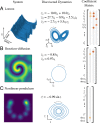Data-driven discovery of coordinates and governing equations
- PMID: 31636218
- PMCID: PMC6842598
- DOI: 10.1073/pnas.1906995116
Data-driven discovery of coordinates and governing equations
Abstract
The discovery of governing equations from scientific data has the potential to transform data-rich fields that lack well-characterized quantitative descriptions. Advances in sparse regression are currently enabling the tractable identification of both the structure and parameters of a nonlinear dynamical system from data. The resulting models have the fewest terms necessary to describe the dynamics, balancing model complexity with descriptive ability, and thus promoting interpretability and generalizability. This provides an algorithmic approach to Occam's razor for model discovery. However, this approach fundamentally relies on an effective coordinate system in which the dynamics have a simple representation. In this work, we design a custom deep autoencoder network to discover a coordinate transformation into a reduced space where the dynamics may be sparsely represented. Thus, we simultaneously learn the governing equations and the associated coordinate system. We demonstrate this approach on several example high-dimensional systems with low-dimensional behavior. The resulting modeling framework combines the strengths of deep neural networks for flexible representation and sparse identification of nonlinear dynamics (SINDy) for parsimonious models. This method places the discovery of coordinates and models on an equal footing.
Keywords: deep learning; dynamical systems; machine learning; model discovery.
Copyright © 2019 the Author(s). Published by PNAS.
Conflict of interest statement
The authors declare no competing interest.
Figures



References
-
- Yao C., Bollt E. M., Modeling and nonlinear parameter estimation with Kronecker product representation for coupled oscillators and spatiotemporal systems. Physica D 227, 78–99 (2007).
-
- Schmidt M., Lipson H., Distilling free-form natural laws from experimental data. Science 324, 81–85 (2009). - PubMed
-
- Rowley C. W., Mezić I., Bagheri S., Schlatter P., Henningson D., Spectral analysis of nonlinear flows. J. Fluid Mech. 645, 115–127 (2009).
-
- Schmid P. J., Dynamic mode decomposition of numerical and experimental data. J. Fluid Mech. 656, 5–28 (2010).
Publication types
LinkOut - more resources
Full Text Sources
Other Literature Sources

